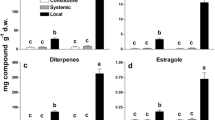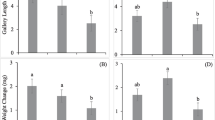Abstract
Two pine species (Pinus resinosa, P. banksiana) responded to inoculation with fungi carried by bark beetles by rapidly increasing monoterpene concentrations at the entry site. Changes in total monoterpenes were more pronounced than changes in proportionate compositions. The extent and rate of host response was affected by fungal species, the viability of the inoculum, and host tree species. In general, host responses were highest to fungi that are phytopathogenic and consistently associated with the major bark beetles in the study region. Simple mechanical wounding cannot account for the observed allelochemical changes, as aseptic inoculations elicited only minor reactions. Similarly, inoculation with autoclaved inviable fungi generally elicited intermediate responses, suggesting that both structural and metabolic fungal properties are important. Responses by jack pine, P. banksiana, were generally more rapid and variable than those of red pine, P. resinosa. Dose-toxicity experiments with synthetic compounds demonstrated that monoterpene concentrations present in vivo only a few days after simulated attack are lethal to most beetles. Constitutive (pre-attack) monoterpene levels can also exert some toxicity. Because bark beetles engage in pheromone-mediated mass attacks that can deplete host defenses, constitutive monoterpene levels, while a necessary early phase of successful plant defense, appear insufficient by themselves. Such interactions between constitutive and induced defense chemistry may be important considerations when evaluating general theories of plant defense.
Similar content being viewed by others
References
Berryman AA (1972) Resistance of conifers to invasion by bark beetle-fungal associations. BioScience 22:598–602
Borden JH (1982) Aggregation pheromones In: Mitton JB, Sturgeon KB (eds) Bark beetles in North American conifers. University of Texas Press, Austin, pp 74–139
Chapin IFS, Bryant JP, Fox JF (1985) Lack of induced chemical defense in juvenile Alaskan woody plants in response to simulated browsing. Oecologia 67:457–459
Cheniclet C, Bernard-Dagan C, Pauly G (1988) Terpene biosynthesis under pathological conditions. In: Mattson WJ, Levieux J, Bernard-Dagan C (eds) Mechanisms of woody plant defenses against insects: search for pattern. Springer, Berlin Heidelberg New York, pp 117–130
Christiansen E (1985) Ceratocystis polonica inoculated in Norway spruce: blue-staining in relation to inoculum density resinosis and tree growth. Eur J For Pathol 15:160–167
Christiansen E, Ericsson A (1986) Starch reserves in Picea abies in relation to defence reaction against a bark beetle transmitted blue-stain fungus Ceratocystis polonica. Can J For Res 16: 78–83
Christiansen E, Horntvedt R (1983) Combined Ips/Ceratocystis attack on Norway spruce and defensive mechanisms of the trees. Z angew Entomol 96:110–117
Cobb FW, Krstic K, Zavarin E, Barber HW Jr (1968) Inhibitory effects of volatile oleoresin components on Fomes annosus and four Ceratocystis species. Phytopathology 58:1327–1335
Cook SP, Hain HP (1986) Detensive mechanisms of loblolly and shortleaf pine against attack by southern pine beetle Dendroctonus frontalis Zimmerman and its fungal associate Ceratocystis minor (Hedgecock) Hunt. J Chem Ecol 12:1397–1406
Coyne JF, Lott LH (1976) Toxicity of substances in pine oleoresin to southern pine beetle. J Ga Entomol Soc 11:301–305
Croteau R, Burbott AJ, Loomis WD (1972) Apparent energy deficiency in mono- and sesqui-terpene biosynthesis in peppermint. Phytochemistry 11:2937–2948
Fowler DP, Lester DT (1970) The genetics of red pine (USDA Forest Service Research Paper WO-8). USDA, Washington
Hain FP, Mawby WD, Cook SP, Arthur FH (1983) Host conifer reaction to stem invasion. Z angew Entomol 96:247–256
Hemmingway RW, McGraw GW, Barras SJ (1977) Polyphenols in Ceratocystis minor-infected Pinus taeda: fungal metabolites phloem and xylem phenols. J Agric Food Chem 25: 717–720
Hunt DWA, Lintereur G, Raffa KF (1992) Rearing methods for Hylobius radicis and Hylobius pales (Coleoptera: Curculionidae). J Econ Entomol 85:1873–1877
Karban R, Myers JH (1989) Induced plant responses to herbivory. Annu Rev Ecol Syst 20:331–348
Klepzig KD, Raffa KF, Smalley EB (1991) Association of insectfungal complexes with red pine decline in Wisconsin. For Sci 37:1119–1139
Klepzig KD, Kruger EL, Smalley EB, Raffa KF (1995a) Monoterpenes and phenolics associated with the response of healthy and stressed red pine to a bark beetle vectored fungus. J Chem Ecol 21
Klepzig KD, Raffa KF, Smalley EB (1995b) Dendroctonus valens and Hylastes porculus (Coleoptera: Scolytidae) vectors of pathogenic fungi (Ophiostomatales) associated with red pine decline disease Great Lakes Entomol:28
Langenheim JH (1994) Higher plant terpenoids—a phytocentric overview of their ecological roles. J Chem Ecol 20:1223–1280
Lerdau M, Litvak M, Monson R (1994) Plant chemical defense: monoterpenes and growth-differentiation hypothesis. Trends Ecol Evol 9:58–61
Lewinsohn E, Gijzen M, Croteau R (1991) Defense mechanisms of conifers Physiol Plant Pathol 96:44–49
Lieutier F (1993) Induced defense reaction of conifers to bark beetles and their associated Ophiostoma beetles In: Wingfield MJ, Seifert KA, Webber JF (eds) Ceratocystis and Ophiostoma taxonomy, ecology, and pathenogenicity. APS Press, St Paul, pp 219–233
Lorio PL Jr (1986) Growth-differentiation balance: a basis for understanding southern pine beetle-tree interactions. For Ecol Manage 14:259–273
Lorio PL Jr (1993) Environmental stress and whole-tree physiology In: Schowalter TD, Filip GM (eds) Beetle-pathogen interactions in conifer forests. Academic Press, New York, pp 81–101
Miller RH, Berryman AA, Ryan CA (1986) Biotic elicitors of defense reactions in lodgepole pine. Phytochemistry 25:611–612
Milliken GA, Johnson DE (1984) Analysis of messy data. Lifetime Learning, Belmont
Mitton JB, Sturgeon KB (eds) (1982) Bark beetles in North American conifers. University of Texas Press, Austin
Myers JH, Williams KS (1987) Lack of short or long term inducible defenses in the red alder-western tent caterpillar system. Oikos 48:73–78
Nebeker TE, Hodges JD, Blanche CA, Honea CR, Tisdale RA (1992) Variation in the constitutive defensive system of loblolly pine in relation to bark beetle attack. For Sci 38:457–466
Nebeker TE, Hodges TE, Blanche CA (1993) Host response to bark beetle and fungal colonization. In: Schowalter TD, Filip GM (eds) Beetle-pathogen interactions in conifer forests. Academic Press, New York, pp 157–173
Paine TD, Stephen RM (1987) Fungi associated with the southern pine beetle: avoidance of induced defense response in loblolly pine. Oecologia 74:377–379
Paine TD, Stephen FM, Cates RG (1988) Phenology of an induced response in loblolly pine following inoculation of fungi associated with the southern pine beetle. Can J For Res 18: 1556–1562
Paine TD, Stephen FM, Cates RG (1993) Host defense reactions in response to Ophiostoma species In: Wingfield MJ, Seifert KA, Webber JF (eds) Ceratocystis and Ophiostoma taxonomy, ecology, and pathenogenicity. APS Press, St Paul, pp 219–233
Popp MP, Johnson JD, Massey TL (1991) Simulation of resin flow in slash and loblolly pine by bark beetle vectored fungi. Can J For Res 21:1124–1126
Raffa KF (1991) Induced defensive reactions in conifer-bark beetle systems In: Tallamy DW, Raupp MJ (eds) Phytochemical induction by herbivores. Academic Press, New York, pp 245–276
Raffa KF, Berryman AA (1982a) Accumulation of monoterpenes and associated volatiles following fungal inoculation of grand fir with a fungus transmitted by the fir engraver Scolytus ventralis (Coleoptera: Scolytidae) Can Entomol 114:797–810
Raffa KF, Berryman AA (1982b) Physiological differences between lodgepole pines resistant and susceptible to the mountain pine beetle and associated microorganisms. Environ Entomol 11:486–492
Raffa KF, Berryman AA (1983a) The role of host plant resistance in the colonization behavior and ecology of bark beetles. Ecol Monogr 53:27–49
Raffa KF, Berryman AA (1983b) Physiological aspects of lodgepole pine wound responses to a fungal symbiont of the mountain pine beetle Dendroctonus ponderosae (Coleoptera: Scolytidae). Can Entomol 115: 723–734
Raffa KF, Berryman AA (1987) Interacting selective pressures in conifer-bark beetle systems: a basis for reciprocal adaptations? Am Nat 129:234–262
Raffa KF, Smalley EB (1988a) Host resistance to invasion by lower stem and root infesting insects of pine: response to controlled inoculations with the fungal associate Leptographium terebrantis. Can J For Res 18: 675–681
Raffa KF, Smalley EB (1988b) Seasonal and longterm responses of host trees to microbial associates of the pine engraver Ips pini. Can J For Res 18:1624–1634
Raffa KF, Steffeck RJ (1988) Computation of response factors for quantitative analysis of monoterpenes by gas liquid chromatography. J Chem Ecol 14:1385–1390
Raffa KF, Berryman AA, Simasko J, Teal W, Wong BL (1985) Effects of grand fir monoterpenes on the fir engraver Scolytus ventralis (Coleoptera: Scolytidae) and its symbiotic fungus. Environ Entomol 14:552–556
Raffa KF, Phillips T, Salom S (1993) Strategies and mechanisms of host colonization by bark beetles In: Schowalter TO, Filip G (eds) Interactions among bark beetles pathogens and conifers in North American forests. Academic Press, New York, pp 103–128
Renwick JAA, Vité JP (1970) Systems of chemical communication in Dendroctonus Contrib Boyce Thompson Inst 24:283–292
Rhoades DF (1985) Offensive-defensive interactions between herbivores and plants: their relevance in herbivore population dynamics and ecological theory. Am Nat 125:205–238
Rudolf TD, Yeatman CW (1982) Genetics of jack pine (USDA Forest Service Research Paper WO-38) USDA, Washington
Russell CE, Berryman AA (1976) Host resistance to the fir engraver beetle 1. Monoterpene composition of Abies grandis pitch blisters and fungus-infected wounds. Can J Bot 54:14–18
SAS (1982) SAS user's guide: statistics. SAS Institute, Cary
SAS (1985) SAS user's guide: statistics. SAS Institute Cary
Schlyter F, Byers JA, Löfquist J (1987) Attraction to pheromone sources of different quantity, quality, and spacing: density-regulation mechanism in bark beetle Ips typographus. J Chem Ecol 13:1503–1523
Schowalter TD, Coulson RN, Crossley DA Jr (1981) Role of southern pine beetle and fire in maintenance of structural and function of the southeastern coniferous forest. Environ Entomol 10:821–825
Whitney HS (1982) Relationships between bark beetles and symbiotic organisms In: Mitton JB, Sturgeon KB (eds) Bark beetles in North American confiers. University of Texas Press, Austin, pp 183–211
Wood DL (1972) Selection and colonization of ponderosa pine by bark beetles. Symp R Entomol Soc Lond 6:110–117
Wood DL (1982) The role of pheromones, kairomones and allomones in the host selection behavior of bark beetles. Annu Rev Entomol 27:411–446
Author information
Authors and Affiliations
Corresponding author
Rights and permissions
About this article
Cite this article
Raffa, K.F., Smalley, E.B. Interaction of pre-attack and induced monoterpene concentrations in host conifer defense against bark beetle-fungal complexes. Oecologia 102, 285–295 (1995). https://doi.org/10.1007/BF00329795
Received:
Accepted:
Issue Date:
DOI: https://doi.org/10.1007/BF00329795




